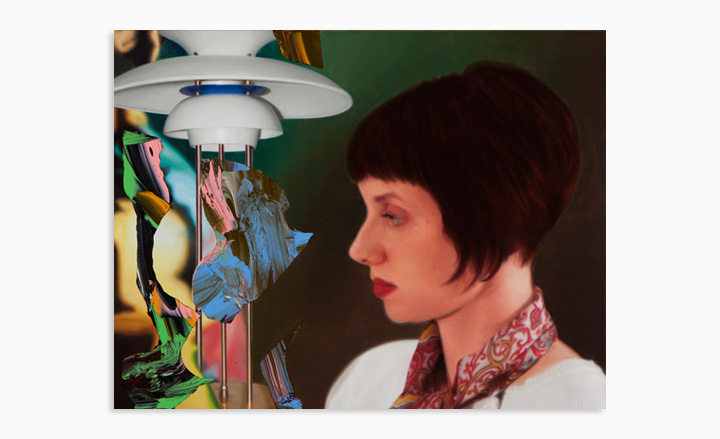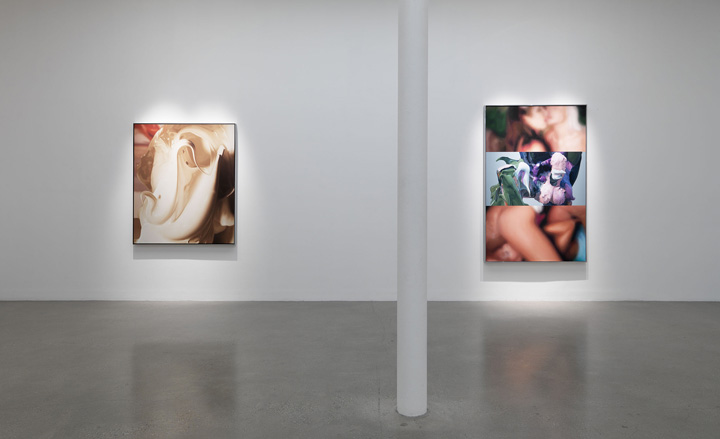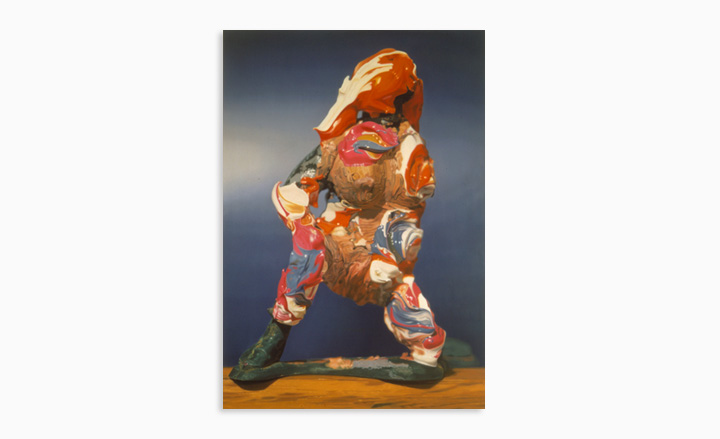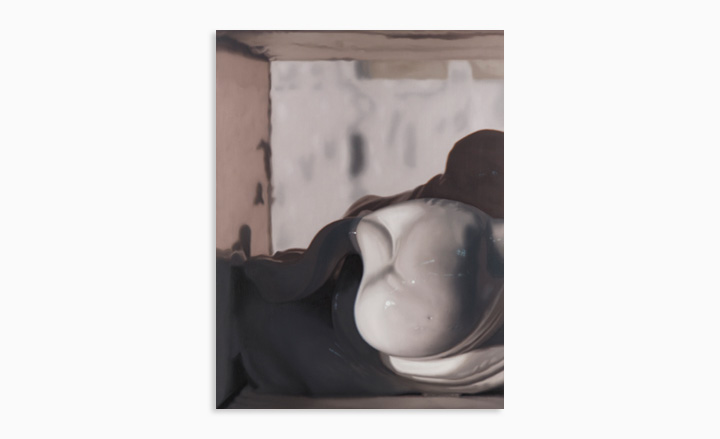Richard Patterson exhibition at Timothy Taylor Gallery, London

A show surveying both new and old works by artist Richard Patterson has just opened at Timothy Taylor Gallery, marking the third major exhibition that the artist has had at the London gallery space to date. The Dallas-based Brit needs no introduction. He wears the mantle of Young British Artist by virtue of his early career: after graduating from Goldsmiths College in 1986, he exhibited at the mythical 'Freeze' exhibition organised by Damien Hirst and thereafter appeared at 'Sensation: Young British Artists from the Saatchi Collection' at the Royal Academy of Arts.
But his arresting installations and sculptural paintings - with influences as varied as Leonardo da Vinci, Giovanni Bellini and Willem de Kooning - put him in an indefinable genre. In 2002 Patterson moved to New York and then on to Dallas, Texas, home of his wife (the curator Christina Rees), where his work began to explore tropes of Americanness, though he says he still feels an affinity for European artists.
His deeply personal work is also immensly critical of societal stereotypes and contemporary status symbols. Patterson often combines hyperrealist self-portraiture with images from pop culture, or paints sculptural figures with a heavy impasto technique, giving them a literal as well as symbolic depth.
Patterson has exhibited across Europe and the US and is much loved by galleries in Dallas and Houston - not to mention Wallpaper*. Back in March 2006 he designed a mixed media cover for the magazine that played on stereotypes of Texan brawn and glamour. The launch of the survey show at Timothy Taylor, which includes work dating back to the mid-1990s, coincides with a new monograph published by Ridinghouse.
We spoke to Richard while he installed the exhibition at the gallery...
The completion of the many-layered 'Culture Station no.1, Zipper' marked a breakthrough for you, but you've had steady success since 1995. How has that changed the nature of your work?
Any success makes you more certain in some respects and less certain in other respects. For instance, it's not very helpful to question who's buying the work. Or who's not buying it.
In your new monograph, Toby Kamps refers to 'enjambment' in your work. Would you say your art is a physical manifestation of poetic enjambment?
Maybe a painting manifestation of enjambment. Toby was quoting James Wood, the literary critic, who wrote a great piece in the New Yorker about the drumming of Keith Moon.
You've said you share with heroes like de Kooning an expression that seems spontaneous but in reality is born of a fastidious process. Can you talk about your affection for de Kooning and other expressionist painters?
I am fascinated with painters like de Kooning, Guston, Bazelitz, Soutine and others because they often tried to break with one tradition or genre in a manner that would have been unfashionable or difficult. That aspect which seems fastidious is as much about trying to do something new.
I'm not interested in Expressionism for the sake of Expressionism. I think there are many myths about Expressionism and how and why it came about. In the movies, Expressionists often seem to adopt that manly 'legs wide apart' posture - like young men at weddings who've never worn a suit before. Even Derek Jacobi as Francis Bacon in John Maybury's 'Love is the Devil' did that corny painting thing where he stares at the canvas with his head cocked to one side, and then draws round an old dustbin lid with heroic super deft super-fast movements, like he's Spartacus.
The reality is that the actual painting process is more like hair, clothes and make-up. Watch films of Robert Motherwell at work, for instance, or even Jackson Pollock and you can see it's fairly measured and predetermined to an extent. John Hoyland liked to shake his paintings a bit to get them to 'loosen up'.
You've said that when you started painting in the late-1980s that the conventional wisdom was that painting was dead. Do you believe that still?
I think it's moved on since the eighties. The conventional wisdom now is that Art is dead.
In 2006 you designed a cover for Wallpaper* that embodied your ideas about modernist architecture. Do you refer to architecture in your other work?
I love the idea of Modernist architecture - not all of it, of course, but some High Modernist designers and architects like Breuer and some of the Scandinavians. Sometimes though, it can be anachronistic in relation to how people live their lives. There is a transparency and austerity to much modernism that isn't suited to how most people are.
The things I did for Wallpaper* (including the spread inside) were originally designs that I was making for myself - very influenced by the usual suspects from the forties and fifties: Neutra, Koenig, Ellwood and that lot. I think architecture is much like composition - one way or another, many of my paintings contain either a direct or indirect reference to architecture.
I've heard you have a passion for music. What music do you listen to or hear in your head as you're creating?
All sorts. Some of it is a deliberate distraction. Some of it is to cheer you up, some to calm you down, some to be reassuring. If it's the middle of the night and you're strung out, you need something great to kind of lift you up and remind you it's worth it. I have a different soundtrack for each painting I'm working on. For example with 'Anna' (2012) I was listening to Ralph Vaughan Williams' 'Fantasia' on the theme of Thomas Tallis Pergolesi Stabat Mater all the time. When I made 'Culture Station No.1, Zipper' in 1995, I listened to Steely Dan's 'Do it Again' as a kind of daily mantra. 'Do it Again' starts with a rhythm track and a cowbell. That's why I ended up bolting a cowbell to the side of the painting.
Is everything really bigger in Texas?
Yes. Most things, like cars, roads, hamburgers and churches - and particularly Bounty paper towels, which I use in my studio a lot for painting rags. They're considerably bigger - by maybe by 50 percent. I come back to England and I can't get over the miniature paper towels.

‘Anna’, 2013

‘Backyard Ritual’, 2004

‘Road Agent’, 2005

‘Portrait of the Artist as an Older Man’, 2009

Patterson's arresting installations and sculptural paintings - with influences as varied as Leonardo da Vinci, Giovanni Bellini and Willem de Kooning - put him in an indefinable genre

The show is a survey of both new and old work by Patterson

The show, which includes work dating back to the mid-1990s, coincides with the launch of a new monograph published by Ridinghouse

'Your Own Personal Jesus', 1995/2011

‘Three times a lady’, 1999

‘Hoxton’, 2000

'Half Minotaur', 2000

‘Christina with green necklace’, 2000

'Gorgeous Loves Urgent', 2010

‘Reef Girl’, 2005
ADDRESS
15 Carlos Place
London, W1K 2EX
Receive our daily digest of inspiration, escapism and design stories from around the world direct to your inbox.
Based in London, Ellen Himelfarb travels widely for her reports on architecture and design. Her words appear in The Times, The Telegraph, The World of Interiors, and The Globe and Mail in her native Canada. She has worked with Wallpaper* since 2006.
-
 Remembering Frank Gehry, a titan of architecture and a brilliant human being
Remembering Frank Gehry, a titan of architecture and a brilliant human beingLong-time Wallpaper* contributor Michael Webb reflects on the legacy of the Los Angeles architect, who died today at age 96
-
 Lexus finally confirms the name of its all-electric LFA Concept supercar
Lexus finally confirms the name of its all-electric LFA Concept supercarStill designated a design study, the Lexus LFA Concept should be the successor to the most unlikely of all 20th-century supercars
-
 King of cashmere Brunello Cucinelli on his new biographical docu-drama: ‘This is my testimony’
King of cashmere Brunello Cucinelli on his new biographical docu-drama: ‘This is my testimony’Directed by Cinema Paradiso’s Giuseppe Tornatore, ‘Brunello: the Gracious Visionary’ premiered in cinematic fashion at Rome’s Cinecittà studios last night, charting the meteoric rise of the deep-thinking Italian designer